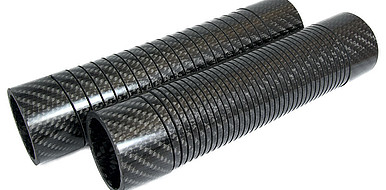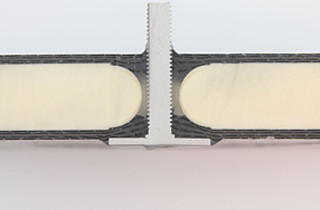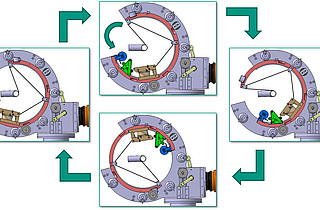XFRP springs with variable fiber combination
Springs are used where components need to transfer loads and still allow elasticity. In the high-performance spring sector of the automotive, robotics or aerospace industries, high strength, good fatigue behavior, corrosion resistance and lightness are required. Common steel springs reach their limits here, mainly due to their high weight.
State of the Art
Better alternatives are springs made of fiber-reinforced plastics, above all so-called GRP springs reinforced with glass fibers or CRP springs reinforced with carbon fibers. They consist of two basic components: the fibers, which absorb the energy, and a plastic matrix, which encloses the fibers as a shaping element. Fiber-plastic composites are anisotropic. Therefore, the properties of fiber-plastic springs are largely determined by the fiber type, fiber content and fiber orientation.
Technology
Researchers of the Institute of Vehicle Systems Engineering at KIT have developed an optimization method for the layer structure and the fiber orientation within the fiber-plastic composite. For the first time, different fiber types are combined in one and the same spring. The X in the designation XFRP springs stands for this fiber variable, in which the fiber concentration and orientation can also be varied within the composite. The fibers are arranged in such a way that an optimum utilization of the fibers takes place over the load cross-section. In this way, the strength of the respective material within the spring is consistently brought to bear, and the stress distribution is homogenized. In the high-performance sector, these are usually particularly resilient and stiff carbon fibers in combination with very flexible and ductile glass fibers.
Advantages
XFRP springs can store more energy per spring length or spring length is saved. The efficiency of the spring is increased while the weight is reduced. New spring shapes become possible, which also simplifies functional integration. With the targeted layer structure, the development team has already been able to demonstrate an increase in work absorption capacity of 35 percent with a simultaneous weight reduction of 65 percent relative to the calculated values of a steel spring with dynamic design.
Options for companies
In the high-performance sector, where low weight is often important and space is limited, XFRP springs open up new application possibilities. KIT is looking for partners for application-specific development projects and series production.
Your contact person for this offer

Innovation Manager Mobility and Information Karlsruhe Institute of Technology (KIT)
Innovation and Relations Management (IRM) Phone: +49 721 608-28460
Email: birgit.schulze@kit.edu



